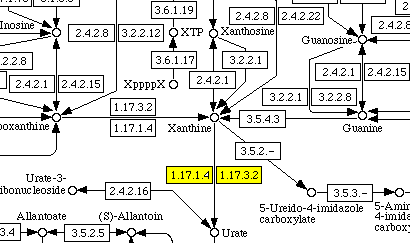Comment
|
----------------------------------
Acts on a variety of purines and aldehydes, including hypoxanthine.
The enzyme from eukaryotes contains [2Fe-2S], FAD and a molybdenum
centre. The animal enzyme can be interconverted to EC 1.17.3.2,
xanthine oxidase (the oxidase form). That from liver exists in vivo
mainly in the dehydrogenase form, but can be converted into EC
1.17.3.2 by storage at -20 degC, by treatment with proteolytic
agents or organic solvents, or by thiol reagents such as Cu2+,
N-ethylmaleimide or 4-mercuribenzoate. The effect of thiol reagents
can be reversed by thiols such as 1,4-dithioerythritol. This enzyme
can also be converted into EC 1.17.3.2 by EC 1.8.4.7, enzyme-thiol
transhydrogenase (glutathione-disulfide) in the presence of
glutathione disulfide. In other animal tissues, the enzyme exists
almost entirely as EC 1.17.3.2, but can be converted into the
dehydrogenase form by 1,4-dithioerythritol. Formerly EC 1.2.1.37 and
EC 1.1.1.204.
|
----------------------------------
An iron-molybdenum flavoprotein (FAD) containing [2Fe-2S] centres.
Also oxidizes hypoxanthine, some other purines and pterins, and
aldehydes (i.e. possesses the activity of EC 1.2.3.1, aldehyde
oxidase). Under some conditions the product is mainly superoxide
rather than peroxide: R-H + H2O + 2 O2 = ROH + 2 O2*- + 2 H+. The
enzyme from animal tissues can be converted into EC 1.17.1.4,
xanthine dehydrogenase. That from liver exists in vivo mainly as the
dehydrogenase form, but can be converted into the oxidase form by
storage at -20 degC, by treatment with proteolytic enzymes or with
organic solvents, or by thiol reagents such as Cu2+,
N-ethylmaleimide or 4-mercuribenzoate. The effect of thiol reagents
can be reversed by thiols such as 1,4-dithioerythritol. EC 1.17.1.4
can also be converted into this enzyme by EC 1.8.4.7, enzyme-thiol
transhydrogenase (glutathione-disulfide) in the presence of
glutathione disulfide. The Micrococcus enzyme can use ferredoxin as
acceptor.
|
Reference
|
----------------------------------
1 [PMID:6960894]
Battelli MG, Lorenzoni E.
Purification and properties of a new glutathione-dependent
thiol:disulphide oxidoreductase from rat liver.
Biochem. J. 207 (1982) 133-8.
2 [PMID:4342395]
Corte ED, Stirpe F.
The regulation of rat liver xanthine oxidase. Involvement of thiol
groups in the conversion of the enzyme activity from dehydrogenase
(type D) into oxidase (type O) and purification of the enzyme.
Biochem. J. 126 (1972) 739-45.
3
Parzen, S.D. and Fox, A.S. Purification of xanthine dehydrogenase
from Drosophila melanogaster. Biochim. Biophys. Acta 92 (1964)
465-471.
4 [PMID:4294045]
Rajagopalan KV, Handler P.
Purification and properties of chicken liver xanthine dehydrogenase.
J. Biol. Chem. 242 (1967) 4097-107.
5 [PMID:6061702]
Smith ST, Rajagopalan KV, Handler P.
Purification and properties of xanthine dehydroganase from
Micrococcus lactilyticus.
J. Biol. Chem. 242 (1967) 4108-17.
6 [PMID:11341925]
Parschat K, Canne C, Huttermann J, Kappl R, Fetzner S.
Xanthine dehydrogenase from Pseudomonas putida 86: specificity,
oxidation-reduction potentials of its redox-active centers, and
first EPR characterization.
Biochim. Biophys. Acta. 1544 (2001) 151-65.
7 [PMID:8224915]
Ichida K, Amaya Y, Noda K, Minoshima S, Hosoya T, Sakai O, Shimizu
N, Nishino T.
Cloning of the cDNA encoding human xanthine dehydrogenase (oxidase):
structural analysis of the protein and chromosomal location of the
gene.
Gene. 133 (1993) 279-84.
8 [PMID:11005854]
Enroth C, Eger BT, Okamoto K, Nishino T, Nishino T, Pai EF.
Crystal structures of bovine milk xanthine dehydrogenase and
xanthine oxidase: structure-based mechanism of conversion.
Proc. Natl. Acad. Sci. U. S. A. 97 (2000) 10723-8.
9 [PMID:11796116]
Truglio JJ, Theis K, Leimkuhler S, Rappa R, Rajagopalan KV, Kisker
C.
Crystal structures of the active and alloxanthine-inhibited forms of
xanthine dehydrogenase from Rhodobacter capsulatus.
Structure. (Camb). 10 (2002) 115-25.
10 [PMID:11848841]
Hille R.
The Mononuclear Molybdenum Enzymes.
Chem. Rev. 96 (1996) 2757-2816.
|
----------------------------------
1
Avis, P.G., Bergel, F. and Bray, R.C. Cellular constituents. The
chemistry of xanthine oxidase. Part I. The preparation of a
crystalline xanthine oxidase from cow's milk. J. Chem. Soc. (Lond.)
(1955) 1100-1105.
2 [PMID:6960894]
Battelli MG, Lorenzoni E.
Purification and properties of a new glutathione-dependent
thiol:disulphide oxidoreductase from rat liver.
Biochem. J. 207 (1982) 133-8.
3
Bray, R.C. Xanthine oxidase. In: Boyer, P.D., Lardy, H. and Myrback,
K. (Eds.), The Enzymes, 2nd ed., vol. 7, Academic Press, New York,
1963, pp. 533-556.
4 [PMID:4342395]
Corte ED, Stirpe F.
The regulation of rat liver xanthine oxidase. Involvement of thiol
groups in the conversion of the enzyme activity from dehydrogenase
(type D) into oxidase (type O) and purification of the enzyme.
Biochem. J. 126 (1972) 739-45.
5 [PMID:2350174]
Carpani G, Racchi M, Ghezzi P, Terao M, Garattini E.
Purification and characterization of mouse liver xanthine oxidase.
Arch. Biochem. Biophys. 279 (1990) 237-41.
6 [PMID:11092937]
Eger BT, Okamoto K, Enroth C, Sato M, Nishino T, Pai EF, Nishino T.
Purification, crystallization and preliminary X-ray diffraction
studies of xanthine dehydrogenase and xanthine oxidase isolated from
bovine milk.
Acta. Crystallogr. D. Biol. Crystallogr. 56 Pt 12 (2000) 1656-8.
|
